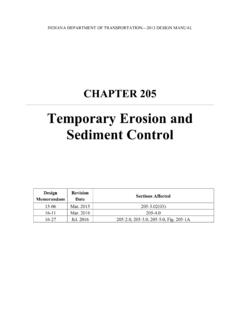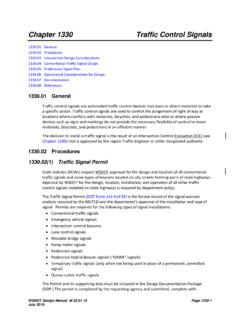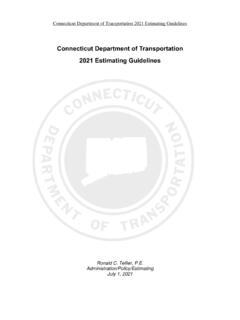Transcription of Reference Guide to Work Zone Traffic Control
1 Reference Guide toWork Zone Traffic Control Infrastructure Training & Safety Institute (ITSI)Texas Engineering Extension Service (TEEX)iRevised January 2011 2011iMaterial in this Guide is largely extracted from the March, 2006 edition of the Manual on Uniform Traffic Control Devices (MUTCD). The user is referred to the MUTCD for all procedures which are not covered in this Guide . This document s specific purpose is for quick Reference by personnel who are familiar with all applicable laws, requirements, and ordinances. Again, the user is referred to the MUTCD for answers to all specific questions and for a complete listing of all requirements. The TMUTCD is available on-line at TxDOT s web site: : This edition of the Reference Guide contains photographs on pages 9, 10, 22 and 26, illustrations on pages 11-12, and narrative on pages 1, 5, 10, 14, 15, 16, 17, 18, 20, 22, 27, 28, 31, 35, 54, and 96 that is not in the TMUTCD.
2 These were added for explanatory purposes to assist TEEX training Reference Guide was prepared in cooperation with the Texas Department of Transportation (TxDOT). Printed March, 2006 2006 Engineering, Utilities and Public Works Training Institute Texas Engineering Extension Service The Texas A&M System Infrastructure Training and Safety InstituteTexas Engineering Extension ServiceThe Texas A&M SystemThis training is provided under Susan B. Hardwood No. 5H-21004-10-60-F-8 awarded to the Texas Engineering Extension Service from the Occupational Safety and Health Administration, Department of Labor. It does not necessarily reflect the views or policies of the Department of Labor, nor does mention of trade names, commercial products, or organizations imply endorsement by the Table of Contents Preface.
3 Iii Principles of Traffic Control Devices .. 1 Fundamental Principles of temporary Traffic Control .. 1 temporary Traffic Control zones .. 3 Summary Lane Closure on a Multi-lane Road .. 17 Lane Closure on a Two-Lane, Two-Way Road Using Flaggers .. 19 Summary Lane Closure on a Two-Lane, Two-Way Road .. 27 Pedestrian and Worker 29 Worker Safety Apparel .. 31 32 Barricades .. 38 Channelizing Devices .. 36 Pavement Markings .. 39 Arrow Panels .. 40 Portable Changeable Message Signs .. 41 Typical Applications .. 41 Traffic Incident Management Areas .. 63 Table 6C-2. Longitudinal Buffer , 21 Table 6C-3. Taper Length Criteria for temporary Traffic Control zones .
4 7 Table 6C-4. Merging Taper Lengths and Spacing of Channelizing Devices .. 8 Table 6C-1. Suggested Advance Warning Sign Spacing ..14 Table 6E-1. Stopping Sight Distance as a Function of Speed ..21 iiiiii Preface In the March, 2006 edition of the TMUTCD, the headings Standard, Guidance, Option, and Support are used to classify the nature of the text that follows. In addition, the text contains variations in type (unbold and bold type) to classify the nature of the text. In the interest of brevity, these headings have been omitted in this Reference Guide , but the type variations (unbold and bold type) have been maintained. 1. Standard a statement of required, mandatory, or specifically prohibitive practice regarding a Traffic Control device.
5 The verb shall is typically used, and the text appears in bold type. Standard text in the Reference Guide appears in bold type. 2. Guidance a statement of recommended, but not mandatory, practice in typical situations, with deviations allowed if engineering judgment or engineering study indicates the deviation to be appropriate. The verb should is typically used, and the text appears in unbold type. iviv 3. Option a statement of practice that is a permissive condition and carries no requirement or recommendation. Options may contain allowable modifications to a Standard or Guidance. The verb may is typically used, and the text appears in unbold type. 4. Support an informational statement that does not convey any degree of mandate, recommendation, authorization, prohibition, or enforceable condition.
6 The verbs shall, should, and may are not used in Support statements, and the text appears in unbold type. 5. Any narrative that was added for explanatory purposes to assist TEEX training efforts is shown in italics. 6. Typical Applications (p. 43-94) were taken from the TxDOT website: 7. Whenever the acronym TTC is used in this Guide , it refers to temporary Traffic Control . 11 Principles of Traffic Control Devices To be effective, a Traffic Control device should meet five basic requirements: A. Fulfill a need; B. Command attention; C. Convey a clear, simple meaning; D. Command respect from road users; and E. Give adequate time for proper response. General The needs and Control of all road users (motorists, bicyclists, and persons with disabilities in accordance with the Americans with Disabilities Act of 1990) through a TTC ( temporary Traffic Control ) zone shall be an essential part of highway construction, utility work , maintenance operations, and the management of Traffic incidents.
7 Fundamental Principles of temporary Traffic Control Experience has shown that following the fundamental principles of Part 6 will assist road users and help protect workers in the vicinity of TTC zones . Road user and worker safety and accessibility in TTC zones should be an integral and high-priority element of every project from planning through design and construction. General plans or guidelines should be developed to provide safety for motorists, bicyclists, pedestrians, workers, enforcement/emergency officials, and equipment, with the following factors being considered: 22 The goal should be to route road users through such zones using roadway geometrics, roadside features, and TTC devices as nearly as possible comparable to those for normal highway situations.
8 A TTC be prepared and understood by all responsible parties before the site is occupied. Road user movement should be inhibited as little as Motorists, bicyclists, and pedestrians should be guided in a clear and positive manner while approaching and traversing TTC zones and incident sites. To provide acceptable levels of operations, routine day and night inspections of TTC elements should be Attention should be given to the maintenance of roadside safety during the life of the TTC Each person whose actions affect TTC zone safety, from the upper-level management through the field workers, should receive training appropriate to the job decisions each individual is required to make.
9 Good public relations should be maintained .. Before any new detour or temporary route is opened to Traffic , all necessary signs shall be in place. All TTC devices shall be removed as soon as practical when they are no longer needed. When work is suspended for short periods of time, TTC devices that are no longer appropriate shall be removed or covered. 33 temporary Traffic Control zones Most TTC zones are divided into four areas: the advance warning area, the transition area, the activity area, and the termination area. Activity Area. The activity area is the section of the highway where the work activity takes place. It is comprised of the work space, the Traffic space, and the buffer space.
10 The work space is that portion of the highway closed to road users and set aside for workers, equipment, and material, and a shadow vehicle if one is used upstream. The optional buffer space is a lateral and/or longitudinal area that separates road user flow from the work space or an unsafe area, and might provide some recovery space for an errant vehicle. Neither work activity nor storage of equipment, vehicles, or material should occur within a buffer space. Table 6C-2 may be used as a Guide to determine longitudinal buffer space. The width of a lateral buffer space should be determined by engineering judgment. Transition Area. The transition area is that section of highway where road users are redirected out of their normal path.


















